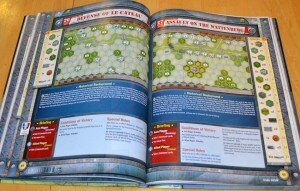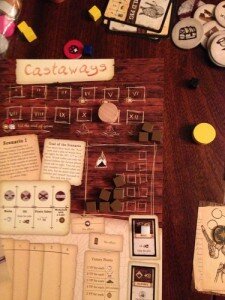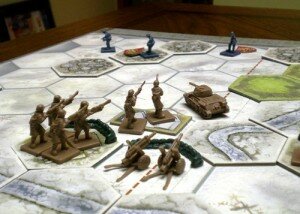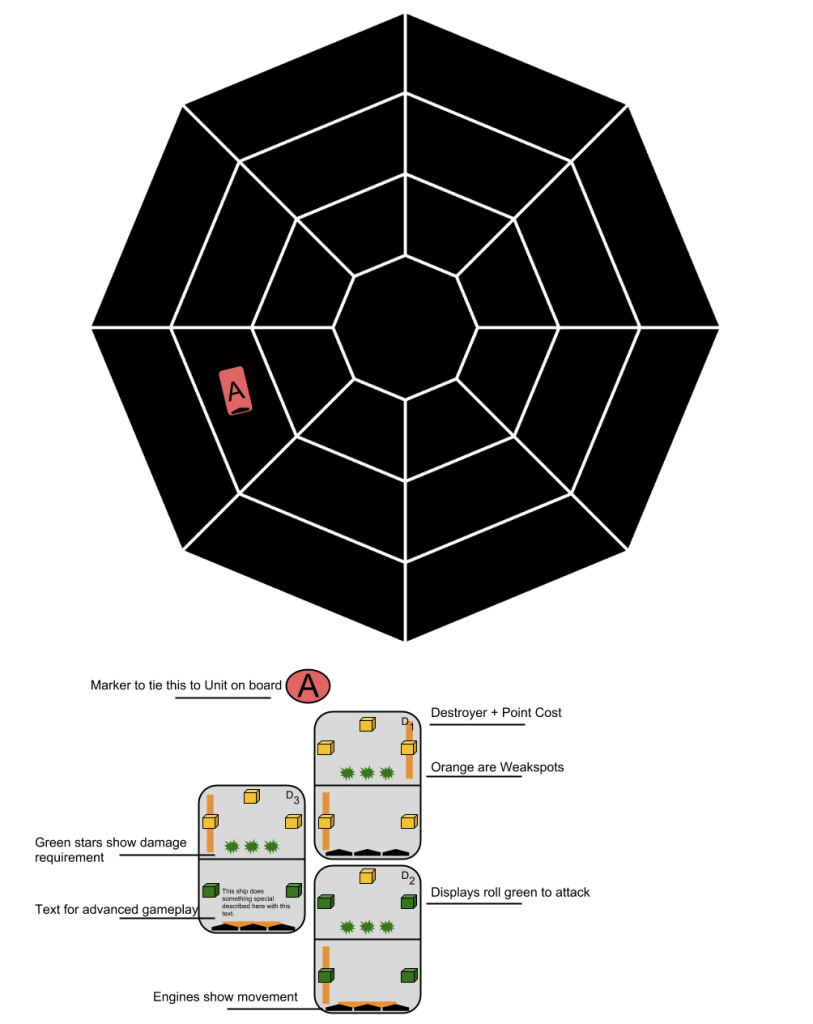Post by: Grant Rodiek
The majority of my development brain is focused on Hocus Poker right now. The revision is testing very strongly and we (me and Josh) think we’ll be able to bring a very pretty version to Board Game Geek Con in November. I spent the past week or so revising the graphics files for Sol Rising and it’s being printed now by Print Play Games. I hope to have a really nice version to show to potential publishers at BGG as well. Other than 2 scenarios, I consider that game largely pitch ready.
That leaves me some free time to work on the next game, which I’ve been doing for some time. My process for a while now has revolved around a long period of contemplation and thought, followed by early rules and design documentation, then prototyping. It’s slow, but it tends to lead to higher quality output sooner.
I want to talk about my new game at a high level. Few details, as those can be distracting. I’ve spent a month or two thinking about its mechanics and the overall experience. I’m deep into the rules and I’ve begun designing content for a first prototype. I’d like to think I’ll have a lightly tested version for BGG Con.
For now, I’m calling it Orb. Purely a placeholder name. Try to figure out what Orb stands for before the end of the post. Your prize is, of course, nothing.
I’ve noted before that my new games are often driven by things I’ve learned, things I’m sick of, and things I’m excited about from my immediate predecessor. After York, I wanted to make a game thematic game that involved dice and scenarios. In this case, moving on from Sol Rising, I’m still interested in science fiction, but I want to leave the confines of a starship and get back to the dirt. I’ve never made a game focused on infantry, so that’s appealing. I want to avoid scenario design and, though I’m not removing dice, I want to bring in richer card play that was absent from Sol.
I knew I wanted to focus on a smaller, more tactical experience. Sol Rising is about fleet command and York is about running a war at the operational level. I wanted to focus on the exploits of a small number of soldiers.
My starting point: Science fiction. Infantry. Tactics.
I started to think about the things in this sector that really excite me and the fictional inspiration was just overwhelming. I LOVE the ODSTs (Orbital Drop Shock Troopers) from the Halo universe (picture at the top). They are the best humanity has to offer, up to the Spartans, that is.
They launch from these small pod capsules and explode onto the ground, directly into the thick of battle. It looks awesome and I plan to have a drop pod mechanic in the game.
There are also the Jump Troops of Charlie Company from one of my favorite cartoons, Exo Squad. These guys would also get into confined pods strapped to exo-suits (like the one Matt Damon wore in Elysium) and would drop into hostile zones on asteriods.
I love drop ships. Futuristic versions of the Chinook or Black Hawk, heavily laden with elite troopers, exiting the belly of a carrier or troop transport in orbit. You see cool ones in Aliens, Halo, Starship Troopers, and other great fiction.
Sci Fi. Infantry. Tactics. Drop ships.
I’m also deeply enamored of Special Forces, both in our current time and in the science fiction I read. There’s something very exciting about highly trained, highly disciplined soldiers who execute their jobs against great odds successfully. I realized this also gave me a great opportunity for a deeply asymmetrical game. A few elite soldiers, no wait, drop troopers, who would need to complete a difficult task against a larger, but less elite force.
Drop Troopers versus Regulars. Assault versus defense. Roles. Already in the design I’m accomplishing this with new tuning variables on how combat is resolved, actions unique to different parties (in general, the drop troopers tend to be more flexible), and objective differences. There’s also a heavy stealth angle for the drop troopers. They need to setup their assault, be patient, then hit with a massive hammer. Once the space poo hits the fan, they need to get out and get home.
This won’t just be two factions, but two different ways to play. This will be an asymmetrical game.
Sci Fi. Infantry. Tactics. Drop ships. Asymmetrical.
War games naturally lend themselves to scenarios. However, after 15 (and counting) Sol Rising scenarios, I’m tired of creating this content. It’s exhausting and requires a unique skill set and energy. Therefore, the need occurred to me to create a dynamic scenario system. By this, I mean I design the framework and content by which the scenarios are created when you play as a part of the experience.
Keep in mind, I will be testing a single framework and content set for the foreseeable future, much like I did with Sol Rising, to verify all of the other mechanics. But, phase 2 will dive more deeply into dynamic scenarios. My current high level thinking is that players will grab cards from a small set for things like terrain (planet type), position (forward operating base, random patrol, heavy base), objectives (rescue hostage, destroy artillery), and any variations (weather, rules of engagement restrictions).
The map and resources available to players will be derived from this setup.
Sci Fi. Infantry. Tactics. Drop ships. Asymmetrical. Dynamic scenarios.
Those are the top items, but there are a few more things I’m working on. I recognize that asymmetrical games have a high degree of a learning curve and one way in which I’d live to curb that is by making the game VERY card driven. I’m planning on a tight, small set of core rules, with few exceptions, and putting almost all of the content onto the cards. Yes, this will make the cards more complex, but I’d rather the rules be IN their hands instead of in their head.
One example relates to the various roles of the special forces units. You don’t need to remember what a sniper can do versus and explosives expert. You’ll have a card to do so. Similarly, if the scenario generator tells you to place a machine gun nest, you don’t need to know what that entails. You just add the cards it tells you and they’ll contain the rules.
That’s all for now. I’ll potentially talk about more specifics as I vet them and feel comfortable doing so. For now, I wanted to talk about the theme, experience, and high level goals in the hopes that some of you are interested. Enjoy your day!







